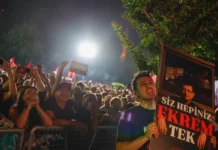By Abdullah Bozkurt
A Russian-Iranian proxy group led by neo-nationalist leader Doğu Perinçek, a close ally of Turkey’s Islamist President Recep Tayyip Erdoğan, has been busy undermining the NATO alliance from within as a Trojan horse following a secret deal between the two politicians that paved the way for convicted officers to not only return to their posts but also get promoted to key positions in the alliance’s second largest army.
Two incidents that took place at NATO’s Joint Warfare Centre (JWC) in Stavanger, Norway, in November 2017 during the Trident Javelin 2017 exercise — which aimed at testing and enhancing NATO command and control in several locations across Europe — exposed the dangerous spillover from the Erdoğan government’s unprecedented purge of Turkish military officers in large numbers. The computer-assisted exercise, which took place between Nov. 6 and 17, 2017 in Stavanger involved a war game called “Skolkan 3” and was based on NATO’s Article V collective defense provision. The drill featured a scenario of a military campaign to restore the territorial integrity of Norway. It also envisaged assistance to nations on the Baltic Sea to re-establish security and stability in the wake of an increasing number of hybrid and cyber-attacks.
Although Norway’s JWC was in charge of the war game, the Supreme Headquarters Allied Powers Europe (SHAPE) was involved at the strategic level and the Allied Joint Force Command Brunssum (JFCBS) in the Netherlands played its part at the operational level. At the tactical level, the NATO Land Command (LANDCOM) in Turkey’s western province of Izmir — which had already suffered a blow from a Turkish military purge — joined the exercise. NATO Maritime Command (MARCOM) in Northwood, UK, and NATO Air Command (AIRCOM) in Ramstein, Germany, provided other assets at tactical levels.
When the drills were nearing an end, a scandal erupted over the targeting of both Erdoğan and the founder of the Turkish Republic, Atatürk, which prompted the overreacting Turkish government to quit the drill and recall 41 officers deployed to Norway. It was reported that a civilian contracted by the Norwegian military in Brunssum in the Netherlands opened a fake account in the name of the Turkish president on NATO’s internal social media network. The Turkish president was pictured as collaborating with an enemy – which, incidentally, is not entirely false given how Erdoğan’s rhetoric and actions have served the interests of the anti-NATO bloc in recent years.
The simulation foresaw Turkey purchasing missiles from the Skolkan Federation (a made-up name for Russia) with which NATO was at war during the digital drills. Remember how Turkey vowed to purchase S-400 long-range missiles from Russia and even dared to replace the stalled F-35 fighter jets with Russian bombers. In the drill, it was also reported that Erdoğan and Putin met after a special message was sent from hostile forces. By the way, let’s not forget that another fake account was also opened on the name of US President Donald Trump in the same simulation.
A technician found a picture of an Atatürk statue on the Internet and used it in the “Hostile Leaders Biographies” section of the computerized exercise in Stavanger. Although in both cases NATO moved quickly to dismiss these people, and NATO Secretary-General Jens Stoltenberg and Norwegian officials scrambled to apologize to Turkey over the incident, Erdoğan capitalized on the scandal to ratchet up his anti-NATO narrative and fuel xenophobia instead of downplaying it and calming the tension. He took up the issue at public rallies to rant and escalate the matter to the point of recalling Turkish officers in what many saw as a tempest in a teapot. He branded Stoltenberg’s apology as “halfhearted” and implied it was intended as a hush-up.
I have talked to several sources on what to make of the incident, and all of them expressed serious doubts over the possibility of such an incident taking place at highly secure NATO bases without a deliberate plot to create an excuse for the Turkish president and his allies, who have been viciously campaigning against Western and NATO allies in recent years. Although NATO was about the wrap up the digital drill in Norway, the Erdoğan government did not wait for its completion to handle the matter discreetly. As if they were waiting for such a scandal, the neo-nationalist Aydınlık daily, owned by the Perinçek gang, ran a headline screaming, “Let’s exit from NATO,” while Yeni Şafak, the pro-Erdoğan Islamist flagship daily owned by Iranian hacks, published a front-page headline declaring that “NATO is an enemy for us [Turkey].”
Moreover, the Erdoğan government used the scandal to add further demands of NATO on issues that were not at all related to addressing the incident. For example, Ankara repeated its demand for the extradition of asylum-seeking Turkish officers who were deployed to NATO posts during the false flag coup bid of 2016 but refused to return for fear of unjust imprisonment. Even though the responsibility for processing asylum applications lies squarely with member states and NATO has nothing to do with that, Turkey used the opportunity to put pressure on allies with a view of bringing back NATO officers to face ill-treatment and torture in Turkish prisons and detention centers, as many have had to endure.
Both Turkish Foreign Minister Mevlüt Çavuşoğlu and then-European Union Affairs Minister Ömer Celik said the dismissal of the two people was not enough and demanded that more heads roll in the chain of command. That included the prosecution of Italian Chief of Staff Gen. Salvatore Farina, who was commander of JFC Brunssum and the NATO Response Force 2018 during the drills. The Turks also dared to ask NATO to drop its critical approach to Turkey in the wake of an unprecedented purge in the Turkish military that inflicted a huge toll on pro-NATO officers who were dismissed en masse on dubious charges. The Ankara Chief Public Prosecutor’s Office even launched a criminal investigation into the incident under case file No. 2017/191238, suggesting that Erdoğan is bent on abusing the criminal justice system to bolster anti-NATO sentiment in Turkey. Deputy Chief Prosecutor Gürhan Özok, who has been one of Erdoğan’s attack dogs, is leading the ongoing investigation in the cybercrimes unit.
Casting further doubt on the credibility of the Erdoğan government’s motivations is the identity of a 40-year old Turkish officer who was reported to have detected the scandal in the secure NATO communications system. Her name is Ebru Nilhan Bozkurt, a Navy lieutenant commander who was convicted and sentenced to five years, 10 months by the Istanbul 11th High Criminal Court for possessing classified documents without authorization on Aug. 2, 2102. She was among 56 civilian and military members who were indicted on Feb. 10, 2011, by Istanbul prosecutor Fikret Seçen on several counts including military espionage, blackmail, prostitution and possessing state secrets. Although the indictment sought 17 years in prison for her, she was not arrested, but the case against her proceeded while she was free on her own recognizance. When her 2012 conviction in the lower court was upheld by the 9th Chamber of the Supreme Court of Appeals on Dec. 7, 2013, Bozkurt fled Turkey to escape an arrest warrant issued for the execution of her sentence.
Bozkurt graduated from the Navy War School in 1998 and served as a lieutenant in a Navy Maritime Patrol Aircraft project called Meltem-2, an important asset for NATO to patrol the southern flank bordering Russia. Her name was discovered in documents obtained from retired Col. Ibrahim Sezer, the number one suspect in the case, during the execution of a search warrant on Sezer’s home. The folder prepared by Bozkurt included six secretly recorded videotapes of Turkish military aircraft while parked in a hangar. The text included in the same folder stated that “all responsible people in the field should videotape important places on their bases by the end of June 2010 and ship them to me [Sezer] via courier, and do not forget to attach explanatory notes on the footage.”
Although Sezer was retired and was not the commanding officer, Bozkurt had her people shoot secret videos of both the exterior and the interior of fighter jets, cargo planes, repair facilities and the tarmac and sent them to Sezer by courier. She also asked her handler for advanced equipment to get better-quality videos because what she used was not capable of getting clear shots. When the prosecutor asked the Office of the Chief of General Staff about the videos and documents, the response was that they would damage Turkey’s national security if they were revealed to the public or passed to enemies.
After Erdoğan’s amnesty and secret deal with the neo-nationalists, Bozkurt was allowed to return to duty in the military as a lieutenant and was assigned to the Cengiz Topel Naval Air Station in Kocaeli province on the western side of Istanbul. She was later promoted to head of the department for an administrative and coordination unit in the General Secretariat of the Turkish Naval Command and was responsible for radar, defense systems and marine and submarine combat capabilities. In the meantime, the panel of judges at the Istanbul 11th High Criminal Court — presiding judge Metin Özçelik, judge Birol Bilen and judge Mehmet Ekinci – that presided over her trial were all sacked by the Erdoğan government and were later thrown in jail on fabricated charges.
Bozkurt claimed that she identified user “RTErdoğan” in a Twitter-like chat program on the afternoon of Nov. 14, 2017, and started following it. In her testimony as a witness at the Ankara prosecutor’s office, Bozkurt remarked that she realized a negative perception was being presented about Erdoğan and Turkey and reported the user to public affairs officers Denver Applehans and Özkan Yüksel of the Allied Maritime Command (MARCOM). The user was removed from the program the next day. The use of Atatürk on the enemy leaders’ list was found out by a Turkish officer named Volkan Atayer, a procurement officer who worked at the NATO Land Command. He said he identified the picture when he was scanning his computer station on Nov. 15, 2017, at 9:05 a.m. and that the picture was removed an hour later after he informed the public affairs officer.
Causing further speculation, in this case, is the fact that Bozkurt was personally selected for the mission in Norway by Rear Adm. Cihat Yaycı, the head of personnel for the Turkish Naval Forces. Not only was Bozkurt’s selection by Yaycı unusual given the fact that such assignments were made from the lower ranks without the involvement of higher-ups, it was also bizarre that Bozkurt decided to inform Yaycı directly about the scandal soon after she found out about it instead of going through the chain of command. The Yaycı’s background gives us some context to better understand this odd relationship between him and Bozkurt.
Yaycı is a notorious figure in the military for leading an ad-hoc, special department called the Judicial Monitor and Scrutiny Administrative Work (ATİŞ, or Adli Takip İnceleme İdari İşlem in Turkish) that profiles officers who are marked for unlawful dismissal. He is the architect of what the Erdoğan government called “FetöMetre,” a set of criteria (reportedly 67 main criteria and 239 sub-criteria) to identify officers who would be dismissed without any effective judicial or administrative probe. Included among them, for example, are individuals who served at NATO posts, had impressive service records, scored high in competitive examinations or excelled in foreign languages. These officers were labeled as untrustworthy, traitors or terrorists by the gang of neo-nationalist and Islamist figures who are now calling the shots in the Turkish military.
Even if the scandal in Norway during the NATO exercise was the work of lone wolfs who hate Erdoğan and Turkey, how the matter was handled by the Erdoğan government and the profile of the people involved from the Turkish military cast a long shadow over the commitment of the current Turkish regime to the alliance’s security. Turkey under Erdoğan is the weakest link in NATO and qualifies as a Trojan horse that collaborates with the enemy.
Perhaps Erdoğan’s fake profile in NATO’s secure communications and chat system did get it right after all. (turkishminute.com)















